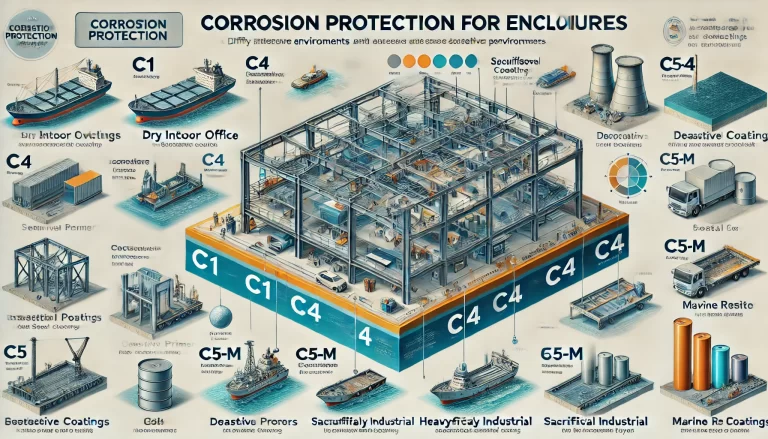1. Introduction to Corrosion Protection Grades Corrosion protection grades define the surface treatment capabilities of materials and structures to resist environmental corrosion. Corrosion refers to the deterioration of materials (primarily metals) due to chemical or electrochemical reactions with their surroundings, leading to compromised performance. In industrial and architectural applications, selecting the appropriate corrosion protection grade is crucial for ensuring equipment durability and safety based on environmental conditions.
The international standard ISO 12944 is widely used to classify and design corrosion protection for steel structures, industrial equipment enclosures, and outdoor installations.

2. Classification of Corrosion Protection Grades Corrosion protection grades are classified based on the corrosiveness of the environment and the metal’s corrosion rate. Below are the key grades:
C1 Grade
Corrosion Environment: Negligible corrosion.
Typical Environment: Dry indoor spaces such as office buildings and schools.
Steel Corrosion Rate: Less than 1.3 μm/year.
Applications: Decorative metal structures, indoor electrical cabinets.
Coating Recommendation: Minimal or purely decorative coatings, such as simple paint finishes.
C2 Grade
Corrosion Environment: Low corrosion.
Typical Environment: Unheated buildings, temporary damp warehouses.
Steel Corrosion Rate: 1.3–25 μm/year.
Applications: Indoor steel components or pipelines.
Coating Recommendation: Single-layer primer with a general-purpose topcoat (e.g., epoxy primer + acrylic topcoat).
C3 Grade
Corrosion Environment: Medium corrosion.
Typical Environment: Urban and industrial environments with moderate humidity and air pollution.
Steel Corrosion Rate: 25–50 μm/year.
Applications: Industrial buildings, external urban equipment.
Coating Recommendation: Three-layer coating system (primer, intermediate coat, topcoat) such as zinc-rich primer (60 μm) + epoxy intermediate (120 μm) + polyurethane topcoat (50 μm).
C4 Grade
Corrosion Environment: High corrosion.
Typical Environment: Chemical plants, swimming pool facilities, coastal areas.
Steel Corrosion Rate: 50–80 μm/year.
Applications: Oil tanks, chemical processing equipment.
Coating Recommendation: Enhanced three-layer coating system with durable zinc-rich primers and high-performance polyurethane or epoxy topcoats.
C5-I Grade (Industrial)
Corrosion Environment: Extremely high corrosion.
Typical Environment: High-humidity, high-pollution industrial zones (e.g., chemical factories, mining equipment).
Steel Corrosion Rate: 80–200 μm/year.
Applications: Chemical facilities, sewage treatment equipment.
Coating Recommendation: High-performance zinc-rich primer + epoxy thick-film intermediate coat + fluorocarbon topcoat with a total dry film thickness of no less than 230 μm.
C5-M Grade (Marine)
Corrosion Environment: Extremely high corrosion with salt exposure.
Typical Environment: Coastal regions, marine climates, ship hulls.
Steel Corrosion Rate: 80–200 μm/year.
Coating Recommendation: Salt-resistant systems comprising:
Primer: Zinc-rich or zinc chromate primer (75–100 μm) for sacrificial protection.
Intermediate Coat: Thick epoxy coating (120–150 μm) to enhance barrier properties.
Topcoat: UV-resistant fluorocarbon or polyurethane paint (50–80 μm).
3. Scientific Principles of Coatings Coating systems work on multiple scientific principles to ensure corrosion protection:
Barrier Effect: Coating materials prevent the penetration of moisture, oxygen, and corrosive ions.
Cathodic Protection: Zinc-rich coatings act as sacrificial anodes, corroding preferentially to protect steel.
Adhesion Strength: Proper surface preparation (e.g., sandblasting to Sa 2.5 standard) significantly enhances coating durability and effectiveness.

4. Practical Application Examples Example 1: Office Building Equipment (C1)
Environment: Dry and controlled.
Coating: Decorative paint with minimal protection.
Lifespan: 10+ years with minimal maintenance.
Example 2: Coastal Oil Tanks (C4)
Environment: High corrosion due to salt and humidity.
Coating: Zinc-rich primer + epoxy intermediate + polyurethane topcoat.
Lifespan: 5–7 years before reapplication.
Example 3: Marine Vessels (C5-M)
Environment: Severe salt exposure and UV radiation.
Coating: High-performance sacrificial and UV-resistant layers.
Lifespan: 10+ years with periodic maintenance.
5. Conclusion Selecting the appropriate corrosion protection grade is vital for ensuring the longevity and functionality of equipment in different environments. The choice depends on the corrosiveness of the environment, the criticality of the equipment, and the ease of maintenance. By adhering to ISO 12944 standards and employing scientifically sound coating systems, industries can achieve long-lasting protection and reduced lifecycle costs.
